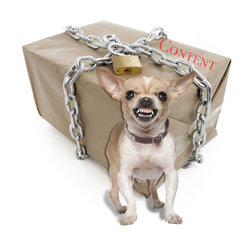 The wonderful thing about content marketing is that you can reach thousands, even millions of people with your message. The downside is that thousands, even millions of people can steal your hard work. You spent the time, effort and money to develop your word, image, video and audio files. You own the work, and it’s worth just a little more effort to protect it from the lazy cyber-shoplifters who might want to pilfer your intellectual property (IP) for their own purposes. RELATED CLASS: Developing a Content Marketing Strategy
The wonderful thing about content marketing is that you can reach thousands, even millions of people with your message. The downside is that thousands, even millions of people can steal your hard work. You spent the time, effort and money to develop your word, image, video and audio files. You own the work, and it’s worth just a little more effort to protect it from the lazy cyber-shoplifters who might want to pilfer your intellectual property (IP) for their own purposes. RELATED CLASS: Developing a Content Marketing Strategy
Protecting your content from content theft isn't hard. The hard part is remembering to do it. If you are putting your content on a third party site like Google Drive or Facebook, review your terms of service (TOS). Yes, I know that most people just scroll to the end and click “Agree,” but if you do that, you may be giving up your copyrights. For example, Google Drive’s TOS says Google can store, reproduce, or recreate any content on their server—even if you stop using the service. By contrast, the TOS for WordPress (operated by Automattic) contains the following verbiage: “By submitting Content to Automattic for inclusion on your Website, you grant Automattic a world-wide, royalty-free, and non-exclusive license to reproduce, modify, adapt and publish the Content solely for the purpose of displaying, distributing and promoting your blog.” That’s not so bad, unless you object to having your blog promoted for free.
1. Protecting Your Photos
Whatever file type you are using, embed the copyright information into the metadata on the file. Image files have a set of metadata that was originally created for photographers to transmit technical details like f-stops, exposures and who the photographer is. You can use this meta-structure to embed keyword rich descriptions, background information and copyright information. All graphics programs like Photoshop, Paintshop Pro, Photoshop Elements, Pixlrator and Appeture have a way to embed this information, usually called “Properties” or “File Info.” This is helpful if someone just steals your image. The Digital Millennium Copyright Act allows you to go to any of the third-party publishers and prove the image belongs to you via this embedded data. They will take your pirated material off their servers and notify the thief. This is usually enough to stop most individuals in their tracks (at least when it comes to your material). People steal content because they are lazy and fighting it becomes more effort than it’s worth.
Keep the highest resolution images behind your firewall. Publicly accessible images should be the lowest resolution you can use that still looks good. Having the highest resolution image also helps to establish your ownership.
Also, any image that you have invested resources in creating should be watermarked at higher resolutions.
2. Protecting Your Audio and Video Files
Audio files also have a way to embed copyright and other information. The metadata are based on recording industry terms like artist, title, length, tracks, etc. Audio files do have areas where you can put copyright info, and you can also often put a synopsis of what you have covered in detail—especially helpful if you have a class lecture or something of a similar nature. Most audio editors will offer this ability.
Videos are a little trickier, depending on how the video was created. The metadata is there, but you can lose metadata when the video is converted. (This can also happen with Flash files.) QuickTime, Windows Media Player and audio editors will give access to this core data that is part of the video file and allow you to claim ownership. If you have converted from one file format to another you may have to re-embed your copyright information prior to posting. RELATED CLASS: YouTube: The Digital Video Advertising Opportunity
3. Protecting Your Documents
If you are making PDFs available for download, copyright information, author and other data are easily inserted in “Properties” and the same is true for Word. When making these files available, be sure to set them as “Read Only” files to prevent others from using your material and trying to hide their theft by changing the files.
On the non-technical side, protecting your material is like a PR campaign, and probably something you should be doing in any case. As soon as you post something, announce it on Twitter, LinkedIn, and all other social media sites that you use. This early announcement allows you to claim ownership. If you have an identifiable author, announce the availability of the material on the author’s Google+ page if they have one. This stakes a solid claim for intellectual ownership.
If someone has actually stolen your files, send cease-and-desist letters and get Google, (or whomever) to send the thief take-down notices. But the core of IP protection is actually getting the copyright information embedded on your webpage and in the file itself. If you put up a video, for example, show a copyright notice on your website somewhere. This gives you a defensible position to prove ownership of your intellectual property.
Do you want to nurture more leads to revenue with relevant content?
Watch Creating Content That Converts: Lean Content Marketing for Lead Generation. In just 30 minutes, you'll learn how to create a high-impact content marketing plan and put it into action immediately. Plus, you'll learn lean content marketing techniques to save time and resources, and how to build your content program around themes and personas. This class is available with a FREE trial to the Online Marketing Institute. Get instant access now.
